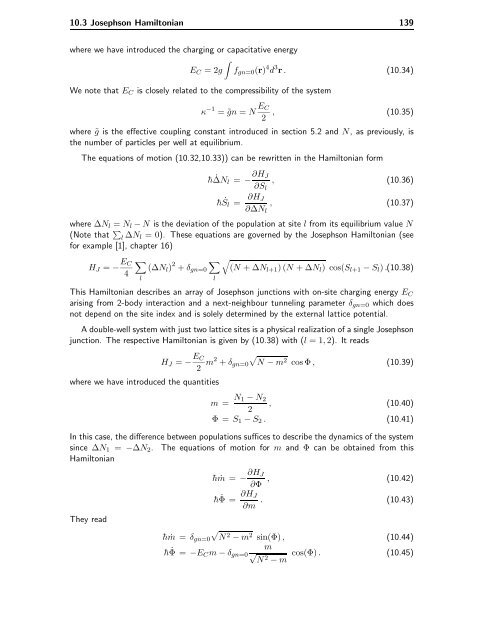Bose-Einstein Condensates in Rotating Traps and Optical ... - BEC
Bose-Einstein Condensates in Rotating Traps and Optical ... - BEC
Bose-Einstein Condensates in Rotating Traps and Optical ... - BEC
Create successful ePaper yourself
Turn your PDF publications into a flip-book with our unique Google optimized e-Paper software.
10.3 Josephson Hamiltonian 139<br />
where we have <strong>in</strong>troduced the charg<strong>in</strong>g or capacitative energy<br />
<br />
EC =2g fgn=0(r) 4 d 3 r . (10.34)<br />
We note that EC is closely related to the compressibility of the system<br />
κ −1 =˜gn = N EC<br />
2<br />
, (10.35)<br />
where ˜g is the effective coupl<strong>in</strong>g constant <strong>in</strong>troduced <strong>in</strong> section 5.2 <strong>and</strong> N, aspreviously,is<br />
the number of particles per well at equilibrium.<br />
The equations of motion (10.32,10.33)) can be rewritten <strong>in</strong> the Hamiltonian form<br />
¯h ˙ ∆Nl = − ∂HJ<br />
∂Sl<br />
, (10.36)<br />
¯h ˙ Sl = ∂HJ<br />
,<br />
∂∆Nl<br />
(10.37)<br />
where ∆Nl = Nl − N is the deviation of the population at site l from its equilibrium value N<br />
(Note that <br />
l ∆Nl =0). These equations are governed by the Josephson Hamiltonian (see<br />
for example [1], chapter 16)<br />
HJ = − EC<br />
<br />
(∆Nl)<br />
4<br />
l<br />
2 <br />
+ δgn=0 (N +∆Nl+1)(N +∆Nl) cos(Sl+1 − Sl) .(10.38)<br />
l<br />
This Hamiltonian describes an array of Josephson junctions with on-site charg<strong>in</strong>g energy EC<br />
aris<strong>in</strong>g from 2-body <strong>in</strong>teraction <strong>and</strong> a next-neighbour tunnel<strong>in</strong>g parameter δgn=0 which does<br />
not depend on the site <strong>in</strong>dex <strong>and</strong> is solely determ<strong>in</strong>ed by the external lattice potential.<br />
A double-well system with just two lattice sites is a physical realization of a s<strong>in</strong>gle Josephson<br />
junction. The respective Hamiltonian is given by (10.38) with (l =1, 2). It reads<br />
HJ = − EC<br />
2 m2 <br />
+ δgn=0 N − m2 cos Φ , (10.39)<br />
where we have <strong>in</strong>troduced the quantities<br />
m = N1 − N2<br />
,<br />
2<br />
(10.40)<br />
Φ=S1 − S2 . (10.41)<br />
In this case, the difference between populations suffices to describe the dynamics of the system<br />
s<strong>in</strong>ce ∆N1 = −∆N2. The equations of motion for m <strong>and</strong> Φ can be obta<strong>in</strong>ed from this<br />
Hamiltonian<br />
They read<br />
<br />
¯h ˙m = δgn=0<br />
¯h ˙m = − ∂HJ<br />
,<br />
∂Φ<br />
(10.42)<br />
¯h ˙ Φ= ∂HJ<br />
.<br />
∂m<br />
(10.43)<br />
N 2 − m2 s<strong>in</strong>(Φ) , (10.44)<br />
¯h ˙ m<br />
Φ=−ECm − δgn=0 √ cos(Φ) .<br />
N 2 − m<br />
(10.45)




